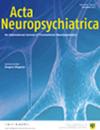外周炎症标志物与双相I型障碍患者脑容量减少相关
IF 2.5
4区 医学
Q1 Medicine
引用次数: 3
摘要
背景:双相情感障碍(BD)中存在神经炎症和脑结构异常。在BD患者的血清和脑脊液中检测到细胞因子和趋化因子水平升高。本研究探讨了BD患者外周炎症标志物与脑亚区体积之间的关系。方法:20 ~ 45岁心境正常的双相I型障碍(BD-I)患者行全脑磁共振成像。在神经影像学当天测定血浆单核细胞趋化蛋白-1 (MCP-1)、几丁质酶-3样蛋白1(也称为YKL-40)、fractalkine (FKN)、可溶性肿瘤坏死因子受体-1 (sTNF-R1)、白细胞介素-1β和转化生长因子-β1的水平。临床数据来自医疗记录和对患者及其他可靠人士的访谈。结果:我们招募了31例患者,平均年龄29.5岁。在多变量回归分析中,血浆水平YKL-40(一种趋化因子)是这些测量中最常见的炎症标志物,与额叶、颞叶和顶叶的各种脑亚区体积呈显著负相关。较高的YKL-40和sTNF-R1水平均与左侧前扣带、左侧额叶、右侧颞上回和边缘上回体积降低显著相关。一生中情绪发作次数越多,右侧尾状核和双侧额叶的体积也越小。结论:已知与BD-I相关的脑区体积可能与较高的血浆YKL-40、sTNF-R1水平和更多的终身情绪发作有关。巨噬细胞和巨噬细胞样细胞可能参与了BD-I患者脑容量的减少。本文章由计算机程序翻译,如有差异,请以英文原文为准。
Peripheral inflammatory markers associated with brain volume reduction in patients with bipolar I disorder.
BACKGROUND Neuroinflammation and brain structural abnormalities are found in bipolar disorder (BD). Elevated levels of cytokines and chemokines have been detected in the serum and cerebrospinal fluid of patients with BD. This study investigated the association between peripheral inflammatory markers and brain subregion volumes in BD patients. METHODS Euthymic patients with bipolar I disorder (BD-I) aged 20 to 45 years underwent whole-brain magnetic resonance imaging. Plasma levels of monocyte chemoattractant protein-1, chitinase-3-like protein 1 (also known as YKL-40), fractalkine, soluble tumor necrosis factor receptor-1 (sTNF-R1), interleukin-1β, and transforming growth factor-β1 were measured on the day of neuroimaging. Clinical data were obtained from medical records and interviewing patients and reliable others. RESULTS We recruited 31 patients with a mean age of 29.5 years. In multivariate regression analysis, plasma level YKL-40, a chemokine, was the most common inflammatory marker among these measurements displaying significantly negative association with the volume of various brain subareas across the frontal, temporal, and parietal lobes. Higher YKL-40 and sTNF-R1 levels were both significantly associated with lower volumes of the left anterior cingulum, left frontal lobe, right superior temporal gyrus and supramarginal gyrus. A greater number of total lifetime mood episodes was also associated with smaller volumes of the right caudate nucleus and bilateral frontal lobes. CONCLUSIONS The volume of brain regions known to be relevant to BD-I may be diminished in relation to higher plasma level of YKL-40, sTNF-R1, and more lifetime mood episodes. Macrophage and macrophage-like cells may be involved in brain volume reduction among BD-I patients.
求助全文
通过发布文献求助,成功后即可免费获取论文全文。
去求助
来源期刊

Acta Neuropsychiatrica
医学-精神病学
CiteScore
8.50
自引率
5.30%
发文量
30
审稿时长
6-12 weeks
期刊介绍:
Acta Neuropsychiatrica is an international journal focussing on translational neuropsychiatry. It publishes high-quality original research papers and reviews. The Journal''s scope specifically highlights the pathway from discovery to clinical applications, healthcare and global health that can be viewed broadly as the spectrum of work that marks the pathway from discovery to global health.
 求助内容:
求助内容: 应助结果提醒方式:
应助结果提醒方式:


